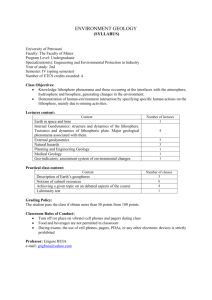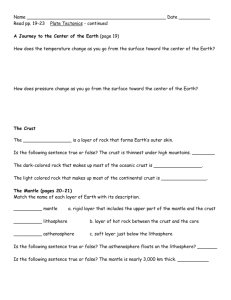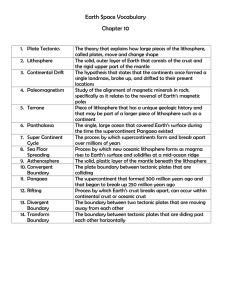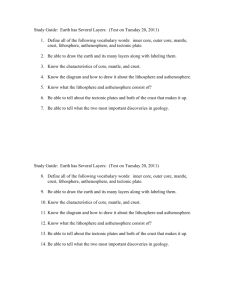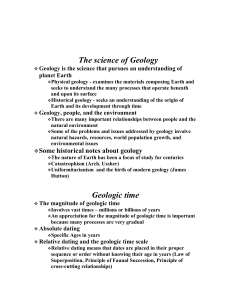Word Document
advertisement
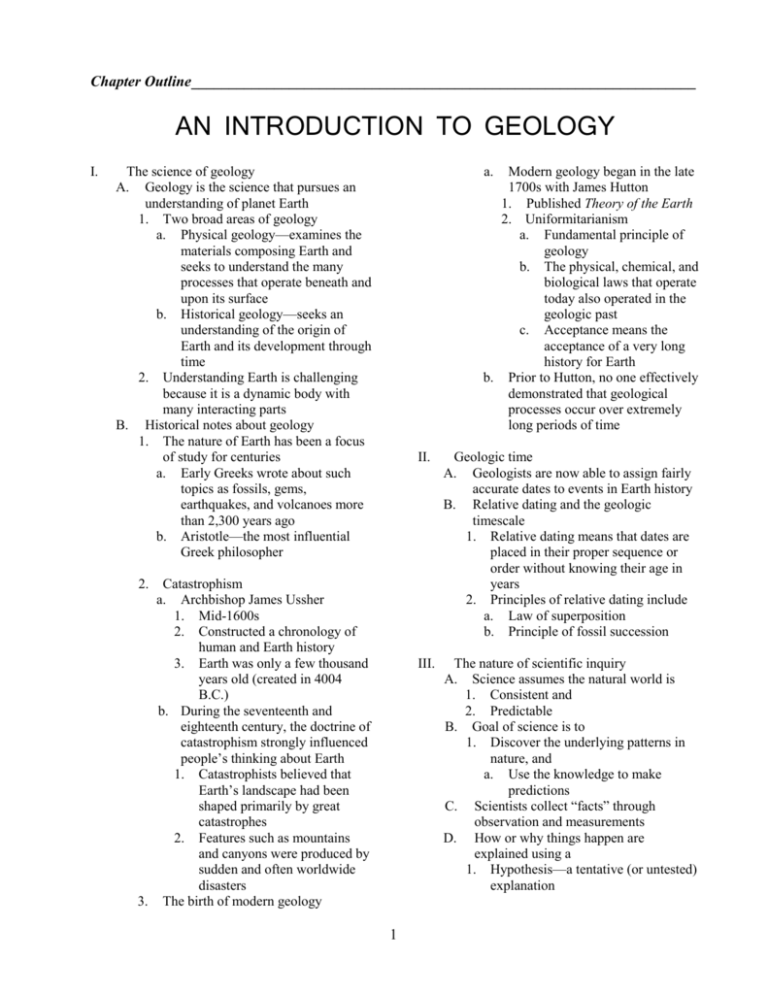
Chapter Outline___________________________________________________________________ AN INTRODUCTION TO GEOLOGY I. The science of geology A. Geology is the science that pursues an understanding of planet Earth 1. Two broad areas of geology a. Physical geology—examines the materials composing Earth and seeks to understand the many processes that operate beneath and upon its surface b. Historical geology—seeks an understanding of the origin of Earth and its development through time 2. Understanding Earth is challenging because it is a dynamic body with many interacting parts B. Historical notes about geology 1. The nature of Earth has been a focus of study for centuries a. Early Greeks wrote about such topics as fossils, gems, earthquakes, and volcanoes more than 2,300 years ago b. Aristotle—the most influential Greek philosopher a. Modern geology began in the late 1700s with James Hutton 1. Published Theory of the Earth 2. Uniformitarianism a. Fundamental principle of geology b. The physical, chemical, and biological laws that operate today also operated in the geologic past c. Acceptance means the acceptance of a very long history for Earth b. Prior to Hutton, no one effectively demonstrated that geological processes occur over extremely long periods of time Catastrophism a. Archbishop James Ussher 1. Mid-1600s 2. Constructed a chronology of human and Earth history 3. Earth was only a few thousand years old (created in 4004 B.C.) b. During the seventeenth and eighteenth century, the doctrine of catastrophism strongly influenced people’s thinking about Earth 1. Catastrophists believed that Earth’s landscape had been shaped primarily by great catastrophes 2. Features such as mountains and canyons were produced by sudden and often worldwide disasters 3. The birth of modern geology II. Geologic time A. Geologists are now able to assign fairly accurate dates to events in Earth history B. Relative dating and the geologic timescale 1. Relative dating means that dates are placed in their proper sequence or order without knowing their age in years 2. Principles of relative dating include a. Law of superposition b. Principle of fossil succession III. The nature of scientific inquiry A. Science assumes the natural world is 1. Consistent and 2. Predictable B. Goal of science is to 1. Discover the underlying patterns in nature, and a. Use the knowledge to make predictions C. Scientists collect “facts” through observation and measurements D. How or why things happen are explained using a 1. Hypothesis—a tentative (or untested) explanation 2. 1 An Introduction to Geology 2. Theory—a well-tested and widely accepted view that the scientific community agrees best explains certain observable facts a. A hypothesis that has survived extensive scrutiny b. Paradigm—a theory that is held with a very high degree of confidence because it explains a large number of interrelated aspects of the natural world E. Scientific methods 1. Scientific method involves a. Gathering facts through observations and b. Formulate 1. Hypotheses and 2. Theories 2. There is no fixed path that scientists follow that leads to scientific knowledge 3. Many scientific investigations involve a. Collecting scientific facts through observation and measurement b. Developing one or more working hypotheses or models c. Development of observations and experiments to test the hypothesis d. Reexamine the hypothesis and either 1. Accept 2. Modify or 3. Reject the model 4. Still other scientific discoveries result from a. Purely theoretical ideas that stand up to extensive examination b. Totally unexpected occurrences during an experiment IV. 1. Hydrosphere a. Water more than anything else makes Earth unique b. Global ocean—the most prominent feature of the hydrosphere 1. Nearly 71% of Earth’s surface 2. About 97% of Earth’s water c. Also includes the water found in streams, lakes, and glaciers 1. Sources of fresh water 2. Responsible for sculpting and creating many of Earth’s varied landforms 2. Atmosphere a. The life-giving gaseous envelope that surrounds Earth b. Without an atmosphere many of the processes that shape Earth’s surface could not operate 3. Biosphere a. Includes all life on Earth b. Influences the makeup and nature of the other three spheres 4. Geosphere a. Extends from the surface to the center of the planet b. Largest of Earth’s four spheres V. A view of Earth A. Earth is a planet that is 1. Small 2. Self-contained 3. In some ways even fragile B. Earth’s four spheres 2 Earth as a system A. Earth is a dynamic planet with many interacting parts or spheres 1. This complex and continuously interacting whole is referred to as the Earth system 2. System—a group of interacting, or independent, parts that form a complex whole a. e.g., Weather system b. e.g., Solar system B. Parts of the Earth system are linked so that a change in one part can produce changes in any or all other parts C. Characterized by processes that 1. Vary on spatial scales from fractions of millimeter to thousands of kilometers 2. Have timescales that range from milliseconds to billions of years D. The Earth system is powered by energy from 1. Sun—drives external processes that occur in the a. The atmosphere b. The hydrosphere, and c. At Earth’s surface 2. Earth’s interior—heat remaining from the formation and heat that is continuously generated by radioactive decay powers the internal processes that produce a. Volcanoes b. Earthquakes, and c. Mountains E. Humans are part of the Earth system VI. a. Solar system evolved from an enormous rotating cloud called the solar nebula b. Nebula was composed mostly of hydrogen and helium c. About 5 billion years ago, the nebula began to contract d. Assumes a flat, disk shape with the protosun (pre-Sun) at the center e. Inner planets begin to form from metallic and rocky clumps of substances with high melting points f. Larger outer planets began forming from fragments with a high percentage of ices—water, carbon dioxide, ammonia, and methane B. Formation of Earth’s layered structure 1. As Earth formed, the decay of radioactive elements and heat from high-velocity impacts caused the temperature to increase a. Iron and nickel began to melt and sink toward the center b. Lighter rocky components floated outward, toward the surface 2. Gaseous material escaped from Earth’s interior to produce the primitive atmosphere The rock cycle: part of the Earth system A. The loop that involves the processes by which one rock changes to another B. Basic cycle ( ) denotes processes 1. Magma 2. (Crystallization) 3. Igneous rock 4. (Weathering) 5. (Transportation) 6. (Deposition) 7. Sediment 8. (Lithification—convert into rock) 9. Sedimentary rock 10. (Heat and pressure) 11. Metamorphic rock 12. (Melting) 13. Magma C. Alternate paths 1. e.g., Igneous rocks become metamorphic rocks 2. e.g., Metamorphic and sedimentary rocks become sediment VIII. Earth’s internal structure A. Earth’s internal layers can be defined by 1. Chemical composition, and/or 2. Physical properties B. Layers defined by composition 1. Crust a. Thin, rocky outer skin b. Two divisions 1. Oceanic crust a. Seven kilometers (5 miles thick) b. Composed of dark igneous rocks called basalt 2. Continental crust a. Averages 35–40 kilometers (25 miles) thick b. Composition consists of many rock types VII. Early evolution of Earth A. Origin of Earth 1. Most researchers believe that Earth and the other planets formed at essentially the same time from the same primordial material as the Sun 2. Nebular hypothesis 3 An Introduction to Geology Asthenosphere (“weak sphere”) 1. Beneath the lithosphere, in the upper mantle 2. Melting in the top portion 3. Lithosphere is mechanically detached and is able to move independently of the asthenosphere c. Mesosphere (or lower mantle) 1. Between 660 and 2900 kilometers 2. Rocks are rigid but capable of very gradual flow d. Core 1. Outer core a. A liquid layer b. Convective flow of metallic iron generates Earth’s magnetic field 2. Inner core a. Strong due to high pressure b. Solid 1. Upper crust has an average composition of a granitic rock 2. Lower crust is more akin to basalt c. Continental crust rocks are less dense and older than oceanic crust rocks 2. Mantle a. Over 82% of Earth’s volume b. Solid, rocky shell c. Extends to a depth of 2900 kilometers (1800 miles) d. Dominant rock in the uppermost mantle is peridotite b. 3. Core a. Thought to be composed of an iron-nickel alloy with minor amounts of oxygen, silicon, and sulfur b. Due to the extreme pressure found in the core, the density is nearly 11 g/cm3 C. Layers defined by physical properties 1. Temperature, pressure, and density gradually increase with depth in Earth’s interior 2. Changes in temperature and pressure affect the physical properties and hence the mechanical behavior of Earth materials 3. Five main layers of Earth based on physical properties and hence mechanical strength a. Lithosphere 1. Consists of a. The crust and b. Uppermost mantle 2. Relatively cool, rigid shell 3. Averages about 100 kilometers in thickness, but may be 250 kilometers or more thick below the older portions of the continents 4. Within the ocean basins it is only a few kilometers thick IX. 4 Dynamic Earth A. The theory of plate tectonics 1. Involves understanding the workings of our dynamic planet 2. Began in the early part of the twentieth century with a proposal called continental drift – the idea that continents moved about the face of the planet 3. Theory, called plate tectonics, has now emerged that provides geologists with the first comprehensive model of Earth’s internal workings a. Earth’s rigid outer shell (lithosphere) is divided into numerous slabs called plates b. The lithospheric plates move relative to each other at a very slow but continuous rate that averages about 5 centimeters (2 inches) a year c. The grinding movements of the plates 1. Generates earthquakes 2. 3. Creates volcanoes, and Deforms large masses of rock into mountains B. Plate boundaries 1. All major interactions among individual plates occurs along their boundaries 2. Types of plate boundaries a. Divergent boundary – two plates move apart, resulting in upwelling of material from the mantle to create new seafloor 1. Occurs mainly at the midocean ridge 2. Mechanism, called seafloor spreading, has created the floor of the Atlantic Ocean during the past 160 million years 3. Along divergent boundaries the oceanic lithosphere is elevated and forms a ridge because it is hot and occupies more volume than cooler rocks b. Convergent boundary—two plates move together 1. Older oceanic plates return to the mantle along these boundaries 2. Descending plates produce ocean trenches 3. Subduction zones are plate margins where oceanic crust is being consumed 4. Whenever continental lithosphere moves toward an adjacent slab of oceanic lithosphere, the less dense continental plate remains “floating” while the denser oceanic lithosphere sinks into the asthenosphere 5. Where one oceanic plate is thrust beneath another, a chain of volcanic structures may eventually emerge from the sea as a volcanic island arc 6. Collisions of continental lithosphere are responsible for the formation of major mountain belts such as the Himalayas, Alps, and Appalachians c. Transform fault boundaries 1. Located where plates grind past each other without either generating new lithosphere or consuming old lithosphere 2. Most are located along midocean ridges d. Changing boundaries 1. Individual plates may grow or diminish in area depending on the distribution of convergent and divergent boundaries 2. New plate boundaries are created in response to changes in the forces acting on the lithosphere 3. As long as Earth’s internal heat engine is operating, the positions and shapes of the continents and ocean basins will change 5




